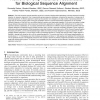2345 search results - page 96 / 469 » Comparing sequence scaffolds |
BMCBI
2007
13 years 7 months ago
2007
Background: Sequence comparison faces new challenges today, with many complete genomes and large libraries of transcripts known. Gene annotation pipelines match these sequences in...
BMCBI
2005
13 years 7 months ago
2005
Background: With the exponential increase in genomic sequence data there is a need to develop automated approaches to deducing the biological functions of novel sequences with hig...
BMCBI
2005
13 years 7 months ago
2005
Background: Exhaustive methods of sequence alignment are accurate but slow, whereas heuristic approaches run quickly, but their complexity makes them more difficult to implement. ...
JCB
2000
13 years 7 months ago
2000
Multiple sequence alignments (MSAs) are frequently used in the study of families of protein sequences or DNA/RNA sequences. They are a fundamental tool for the understanding of th...
TC
2010
13 years 6 months ago
2010
—The most pervasive compute operation carried out in almost all bioinformatics applications is pairwise sequence homology detection (or sequence alignment). Due to exponentially ...

